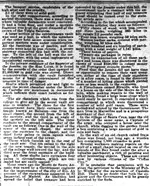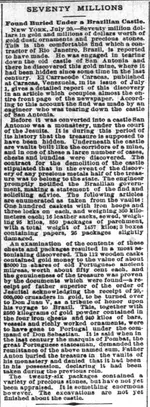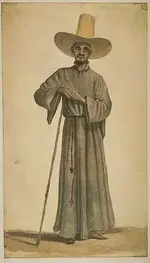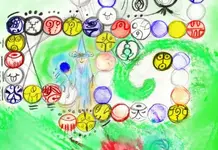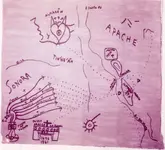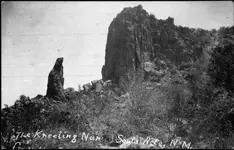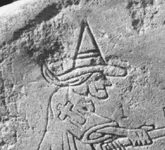Cactusjumper wrote
Guys, so far, it's only stories and pictures which can all be manufactured. No real authentication by experts.
Good luck,
Joe
This is ignoring rather strong evidence entirely. The Santa Rita silver mine, one of several Jesuit mines in Arizona, was rediscovered with hundreds of thousands of tons of rich silver ore already mined out. The piles of slag found at Tubac and Tumacacori, and built into the walls of two missions (at least) should show the trail. A sizable amount of precious metals was mined during the missionary period. Clearly some was smelted at the missions themselves. Where is all of that silver and gold?
By your standard, the Amber Room must never have existed, because all we have a stories of it. There are photos, but photos can be doctored. Likewise, any gold bars or silver, which may or may not have some markings indicating Jesuit ownership or linkage, are dismissed as fakes, hoaxes. However we have the empty hole left by the removal of rich ore at a number of mines, the listing of mines owned openly by the Jesuits in the study mentioned before, the mines which apparently belonged to the "Missions" as pertaining to them as listed by Nentvig's interesting study "Rudo Ensayo", and the products of those mines were mostly silver, and also gold and copper. Where did all of that precious metal go?
We have a clue in the complaint by Kino about his shipment of silver that got stolen en route, and in the shocking end of the Jesuit period in Spanish America, that they were strongly suspected of being engaged in high treason against the Spanish crown, even to the point of an intention to betray the Spanish colonies to the Dutch, and in a few places, to the English. We have corroborating evidence not only from the Spanish oblique statement "...reasons which we keep in our Royal mind..." but from Dutch and English contemporary sources as well, whom were pleasantly surprised at the friendly relations they were enjoying with the Jesuit missions and missionaries, in some cases apparently providing a source of resupply and rest for Dutch, French and English pirates and privateers operating in the Pacific. Now consider the Tayopa inventory document, which dates to almost the same time as the shocking accusations from Bishop Palafox, which accustions including that the Jesuits had and were operating "rich silver mines" in Mexico. I have not seen anyone successfully refute the Tayopa inventory document, found by former West Point officer Henry O. Flipper as a fake or hoax. Even the Molina document**, which includes a sort of inventory, may be a listing of the hoarded treasures, not to mention the estimated $40,000 worth of silver in the altar service seen by visitors to San Xavier del Bac on many occasions, but yet is missing today. Are you taking the stance that this impressive silver never existed?
** - the Molina document is widely dismissed as a fake or hoax, the obvious errors and inexplicablly early dates mentioned being pointed to as clear proof the document has to be false, yet in truth we can not make such conclusions at all since the Molina document as is known in the public eye, is a COPY of an original document. So we do not know what the original may or may not read, or if the copyist made deliberate changes to the text, dates, numbers etc as a protection.
We can also recall that Rudo Ensayo included several GOLD mines as belonging to the Jesuit missions, including one located near Guevavi that was "not being worked" at the moment the Ensayo was being written, and recall that the mission (visita) of Calabasas was specifically listed as having rather poor gold mines nearby which provided the main source of income for that mission. Where did all of the silver and gold GO? It was clearly not being shipped out of Arizona, and apparently not being shipped out of most of Mexico except at sporadic intervals and surreptitiously, as were the cases with the strange meeting of a caravan of mules loaded with silver from Tayopa encountered unexpectedly by a Spanish explorer whom was exploring the gulf of California and landed to acquire fresh water.
This has been litigated at exreme length in another thread, titled "Jesuit Treasures Are They Real?" and really this discussion belongs there, so my apologies to the thread owner for continuing off topic. I have only one more point to address, namely the slavery issue.
The Jesuits owned slaves. We might consider the Mission Indians to be slaves as well, for they were NOT free to come and go as they pleased, they had to obtain permission of the padres to do so, including for simple commerce or a hunting trip, and were forced to labor for three days per week. A three day work week may not sound so bad to us today, but consider if you were FORCED to labor for three days per week, under threat of the whip, the stocks, jail, or even starvation! And not just yourself, but your family as well! But the African slaves were also owned by the Jesuits in America, and in Europe as well. It has been pointed out that slavery was not only common but entirely legal, yet it is a stain on the honor of the Order that they were the largest slave holders in Maryland for some time, and when expelled from the French colony of New Orleans were found to have literally dozens and dozens of slaves, not to mention being directly involved in the ugly slave trade business itself. African slaves were even introduced into Sonora by Jesuits, as teh local Indians were not surviving well working in the mines and sugar cane industries where the Jesuits were using them.
Lest we conclude that the Franciscans were utterly innocent of any such ugly activities as mining, slavery and hoarding of treasures, we have a number of examples to their record as well, such as the interesting and tragic attempt by the intrepid father Garcia to found missions on the Colorado river, in which the mining of GOLD was one of the main enterprises. In this case, from a Franciscan source, we have it that the treasure that had been accumulated at the mission has long ago been located and extricated by Mexican treasure hunters. Likewise, we have records of at least two similar treasures (but including coins not just raw gold or silver) found at least two of the Franciscan missions in California. Side point here but to Tom in CA, I would point out that California was indeed a part of Spanish America, as were Arizona, New Mexico, Colorado, Utah and Nevada, so you have indeed been visiting the northern territory of Spanish America. The Franciscan missions of California, mostly founded by the famous father Serra, were also targeted by pirates for their treasures, Hippolyte de Bouchard raided the Presidio of Monterey in 1818 and others.
Hippolyte de Bouchard and His Attacks on the California Missions
I would also point out that we are very much latecomers in the search for mission treasures, many others have gone ahead of us and with some success. In those early days of treasure hunting, documents were readily found at the old missions, and obtained for the taking. In fact in the American period, the padres were selling the old Jesuit documents for a dollar each. We should not expect to find the absolute, damning evidence that some apologists seem to demand before being 'convicted', even if that denial of true history is in a way worse than the open confession of ancient wrongs. We ought not whitewash the history of the padres in Spanish America, for they were indeed guilty of some wrongs, and at the same time we ought not damn them entirely for they were bringing 'civilization' to the natives, including education and foods (the so-called 'Columbian exchange' which included wheat, later a vital element of native survival) albeit with some dark chapters or aspects as well.
Every statement I have made in this thread can be backed up, in fact nearly all of it has already been posted in the other thread (Jesuit Treasures Are They Real?) so my apologies for the repetition, especially for my friends whom have had to wade through my verbal diarrhea on so many occasions, and for the VERY long post yet again. If I may suggest that we take this part of this discussion to that other thread, which IS focused on the question of Jesuit treasures, and by extension, to include the Franciscan activities in this field as well.
Good luck and good hunting amigos, I hope you find the treasures that you seek.
Oroblanco





OOPs almost forgot, here is the link to the relevant thread, where this discussion rightly belongs:
http://www.treasurenet.com/forums/jesuit-treasures/153540-jesuit-treasures-they-real.html







